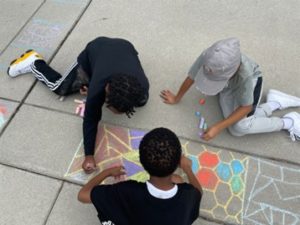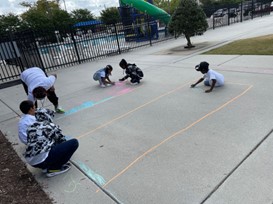*This blog is a guest post by Becky Schnekser.
“We get to go OUTSIDE?” an explorer inquires loudly across the learning space.
“YES! Let’s gather our materials and GET OUTSIDE,” I reply as my explorers frantically gather chalk, their brainstorm sheets, clipboards, and create a haphazard line at the door.
Have you wanted to take learning outdoors? Are you unsure where to start? Here’s a peek into my recent edventures (see what I did there?) with my explorers outdoors.
Geometry
While reviewing basic geometric shapes, my explorers were challenged with creating a piece of art. While inside our learning space, they created drafts of their ideas on whiteboards and paper. That’s when the idea popped into my head, why not bring this idea outside? My school is in an urban area, a pseudo concrete jungle if you will and it is not always instinctual to integrate outdoor learning in this type of area. But did you catch what I mentioned, pseudo concrete jungle; there is plenty of space perfect for drawing and modeling. This is where the idea to create sidewalk art, integrating geometry, art, and the outdoors was formed. We are surrounded by buildings with beautiful graffiti, some commissioned by local artists. This was the perfect opportunity to connect to our local community, connect mathematics with art, and best of all, bring our learning outdoors! In addition to these great community and curricular connections, it served as a great introduction to tessellations and patterns in nature that will pop up in our learning content later in the season.
 Collecting and Graphing Data
Collecting and Graphing Data
In preparing for data collection and analysis, I wanted to find a new way to spice up the content. Sometimes, collecting and graphing data can become stale, why not take the opportunity to integrate the outdoors? This activity was a “double whammy”, we went on a nature walk and counted trees, bushes, and small flowering plants. I let my explorers decide what they wanted to count, but this could also be a great way to intentionally integrate science. For example, if you are studying insects, you could focus on different types of insects, and graph that data. For this activity though, I chose to focus solely on being outdoors, collecting, and graphing data. After our nature walk, explorers then used a large square on the sidewalk to create a bar graph together using chalk.
A common misconception of outdoor education or teaching outdoors is that you need an elaborate or even deliberate setup. This could not be further from the truth; you just need the outdoors. Whether it is a well-defined outdoor learning space, or sidewalk bordered urban area: simple observations of your space are a great start–what is here? What is not here? Using an outdoor area for independent reading time or reader’s theater is another great introductory opportunity for learning in the outdoors. You can BYOS (bring your own seat), BYOT (bring your own towel), or just sit on the ground! I’ve seen many configurations from tree stump stools, cutting boards, milk crates, and overturned buckets. The outdoors is really what you make of it.
Need some inspiration? Want to connect further? You can find me on social media @schnekser or via email [email protected].
*Image courtesy of Kamaljith K V via Wikimedia Commons.


 Collecting and Graphing Data
Collecting and Graphing Data